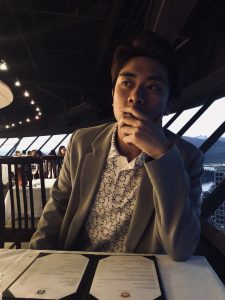ENGL 100
 ABOUT ME
ABOUT ME
My name is Robert Zhang. I was born in Qingdao China. I moved to Canada on 2012. I stayed in Canada for 6 years now, and I lived in Richmond. After I graduated from Robert Alexander Mcmath secondary school. I went north to Capilano University. I am currently in Tourism Management Co-op program. I am interested in tourism industry and try to develop International Tourism in the future. Use my language advantage; open up the market in china. I believe that tourism will have a great sensation in China. I will continue to study at Capilano University. Hopefully get a good grade and pursue my goal. I am currently working as a member of the activities department at the Chinese Student Union. We have hosted many commemorative events, such as Halloween, Spring Festival Evening and various activities with other universities. This is an honor for me and I will use my value in other fields in the future.
These two blog posts were written for English 100 and focus on two articles on the issues of future overpopulation and urban development topics.
In the article”The Modern City Re-invented: A Conceptual Model for Sustainable Urban Form”. Shafik I. Rifaat presented a new approach to solve the problem of overpopulation and unsustainable global urbanization. Overpopulation will be a very important factor in the future (Fig.1). It can lead to population intensification, serious urban pollution and lack of public resources. In response to these questions, Rifaat proposes a detailed solution. He developed a plan for new cities in the future. This will allow more people to live. Public transportation like walking, bicycle and roadway system is the main transportation in this city. This can reduce a lot of Co2. Also, the roadway system will be lined with fruit trees for public consumption; this will provide fresh vegetables and fruits for the resident of the model city (20). From this point of view, this plan will greatly help the future development. In my opinion, I agree with Rifaat’s plan for the future city, but at the same time I think this is a difficult plan to achieve. First of all, many people have also noticed the crisis of future population and resources. They will build more convenient facilities, but most of them valued on the benefits, only few value on the environment protection. Second, building this requires a lot of money and manpower. I don’t think the government will focus on this right now. We all hope that our life will get better and better, maybe this idea will be realized one day in the future.
In the article”This Is Not a Slum: What The world can learn From Dharavi”, Matisa Echanove and Rahul Srivastav describe the urban development of Dharavi and the issue of population inhabitation. The word slum has brought many negative effects to people in this city, and it is a word they want to get rid of. “Slum is not an innocent word. It reinforces….move toward real estate expansion”. (21) They used the reasons for land development and urban construction to drive vulnerable groups out of their homes to make them unemployed. This forced them to live in the refuge of the city; this reflects the continuous updating of shelter and business by residents over generation. They use limited land to create more space for the poor to live, and create structures for rentals and sub-rentals that make living more affordable. Slums are a phenomenon that generally occurs and develops. All countries have a process of understanding, from neglect to attention, from exclusion to acceptance. Each country has adopted a different approach to the treatment of urban slums. This article meant to reflect the vitality and adaptability of Dharavi; these are what developed countries and those have not yet developed need to learn from.